Dungeonborne Class Tier List – Best Class

Dungeonborne has eight unique classes for players to choose from, each with their own skills and abilities. I will explain and rank all of these classes to help you create your next Dungeonborne character.
All Dungeonborne Classes, Ranked
Each Dungeonborne Class is rated in the table below from S-Tier to C-Tier. Each class earns its rank based on how well it performs when solo ranked as well as playing with others.
| Rank | class |
|---|---|
| S | Swordmaster |
| A | Death Knight, Druid, Fighter, Pyromancer |
| B | Rogue |
| C | Cryomancer, Priest |
Best Classes to play in Dungeonborne
This list ranks every Dungeonborne class starting with the best and ending with the worst. While the first and last rankings are quite far apart, those in the middle (from Druid to Death Knight) are fairly evenly ranked. Their specific placements on the list were chosen based on their specific skills, mechanics and how easy they are to learn.
1 – Swordmaster
Strengths: Good at starting and ending battles and hunting down enemies. Can enter stealth mode by crouching while standing still.
Weaknesses: It is necessary to have a constant supply of one-handed weapons to use his abilities, which can easily damage teammates.
The Sword Master is an easy S-Tier pick for both solo and group players. They are strong melee fighters who use primarily two- and one-handed weapons to overwhelm their opponents with speed and strength. Their spells deal a lot of damage but will require players to sacrifice 1-4 swords for each use. I found it easiest to stick to the E spell as it only requires one sword which can easily be replaced by finding it in the dungeons or buying it directly from the merchant. It spins around you similar to the Fighter’s Whirlind while allowing you to fight and defend as you normally would.
Swordmasters are elves just like Druids, so they can crouch and freeze to enter Stealth mode. This makes them invisible, giving them time to heal and allow enemies to pass before advancing. The biggest problem with this class is how easy it is to damage allies with your main attacks and abilities. This isn’t a problem in solo because you can’t harm yourself. However, you’ll want to be paired with a Fighter or other long-range fighter to create a more reasonable composition when in a team.
2 – Druid
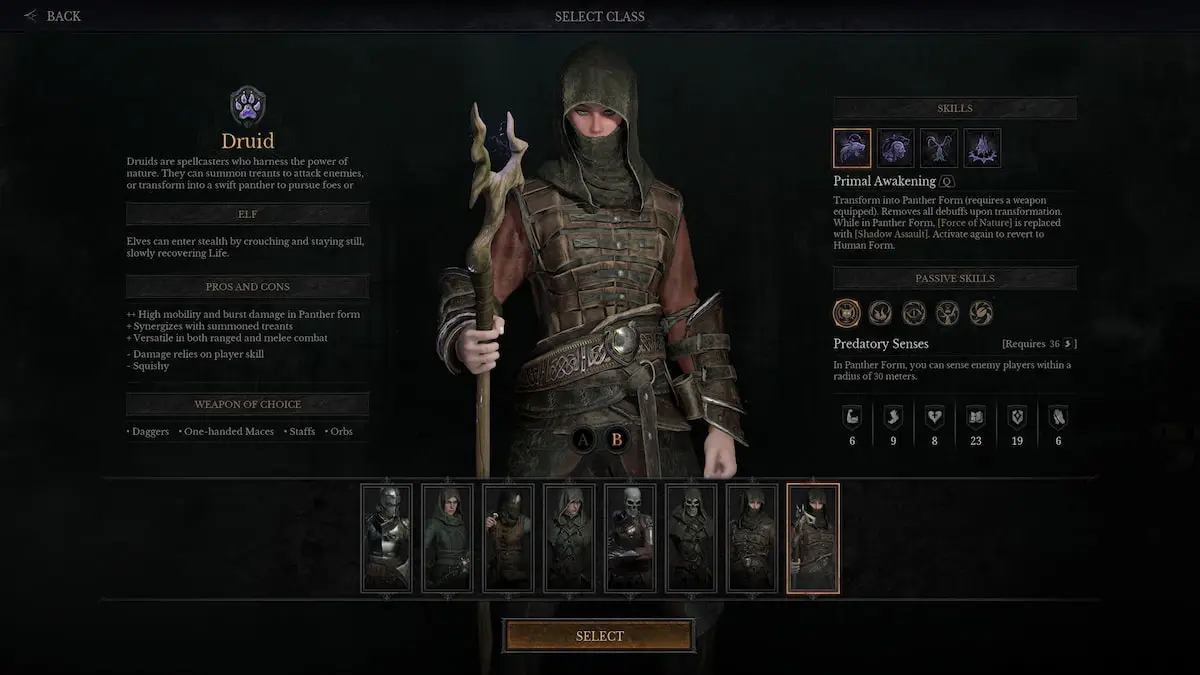
Strengths: Druids are very mobile and able to hold up in both ranged and close combat. Like the Sword Master, their elven ancestry allows them to enter Stealth by crouching and standing still.
Weaknesses: They are physically swinging. Using them correctly requires practice and good posture.
Much mystery surrounded the Druid role in Dungeonborne. This is partly because it is the newest role and partly because many players have chosen to forgo learning this role in exchange for mastering some of the more physically overwhelming ones. Although it may be controversial, I have found Druids to be one of my favorite classes to use in team compositions. A big part of this is the fact that a Druid Dexterity upgrade can enable them to spot enemies within 30 meters of them while in their panther form.
On several occasions in runs, I narrowly saved my team from being attacked by calling out enemy positions before they even detected my trio. As a bonus, if you analyze the weapons and armor of the enemies you can guess their classes with reasonable certainty. It is much easier to deal with a team with a rogue, wizard and swordsman if you know their identities, where they are, and the types of weapons they have. It allows your team to prioritize objectives and create a game plan before the battle has begun.
This passive ability isn’t the druids’ only claim to fame. Their Panther transformation allows them to do some gentle scouting while easily moving in and out of fights and dealing poke damage. They can also summon Treants to attack players and enemies in a designated area. It can damage a group of enemies in one go, protect you or your teammates while you heal, or even be used as a lethal way to block an enemy player’s escape route. If you’re taking a lot of damage or waiting to open a portal, keep crouching and standing still to enter stealth mode. Because druids are of the Elf race, they can enter into secrecy and slowly heal their life force in unseen safety. It’s a great opportunity to kick in and use a consumable like a bandaid or health potion.
3 – Fighter
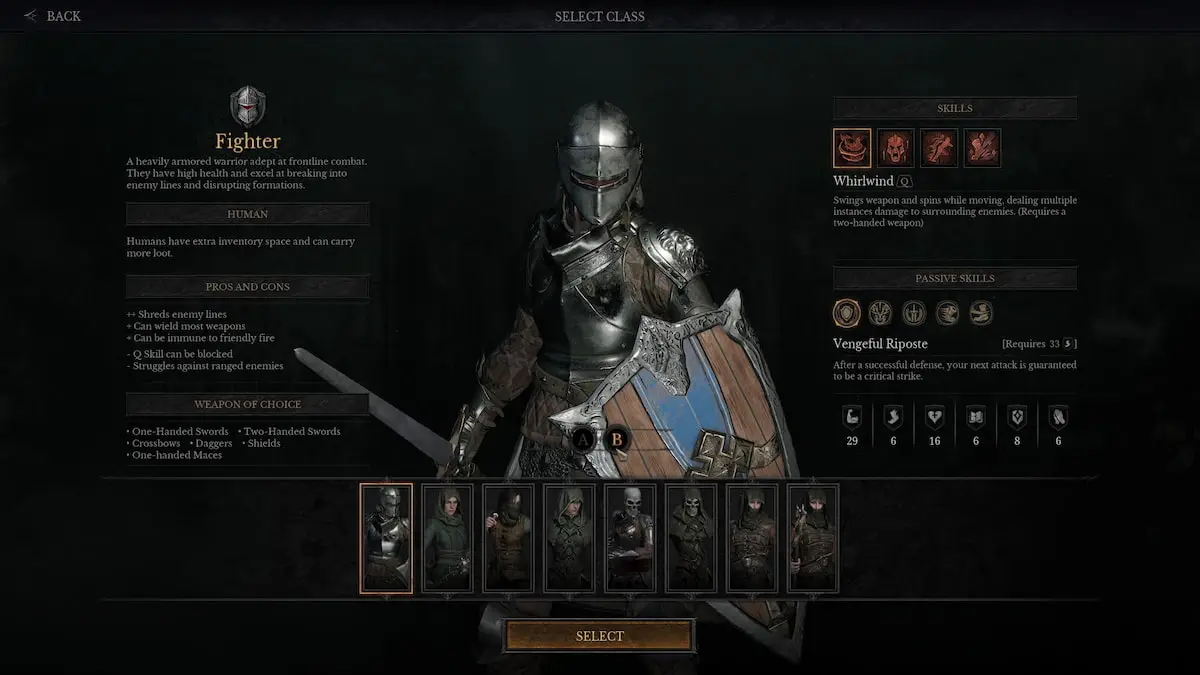
Strengths: Friendly fire immunity ability, close combat combat.
Weaknesses: Ranged combat, vulnerable during Q ability.
The Fighter is the first class player test and one of the easiest to learn mechanically. It feels like your basic sword-and-shield carry, slashing hero complete with a powerful secondary Q attack and an E ability that gives itself some sand. Their Whirling Q Skill is most powerful due to the developers greatly increasing the amount of damage that heavy weapons do. This makes it easy to use monsters and enemy players alike in the lower stages of the game. However, it can be easily countered by those who are proficient in the upper ranks. This does not mean that Fighters will become obsolete in higher ranks. Instead, you’ll just need to play a little more thoughtfully.
One of the bigger advantages of Fighters is that their abilities can be upgraded to prevent them from taking or dealing damage to their teammates. This makes them the perfect class to pair with other fighters in Dungeonborne. They will be able to push the front lines with wild abandon as their teammates join in without possibly getting killed or killing their allies. This may not seem like much, but it can change the way your team fights and how quickly resources are used. I’ve personally had a lot of trouble with using spells and attacks in a team because of how easy it is to hurt a teammate in the process. If I had a Fighter with the anti-friendly fire upgrade on my side, I would have been able to relax and just focus on taking down the enemies in front of me.
4 – Pyromist
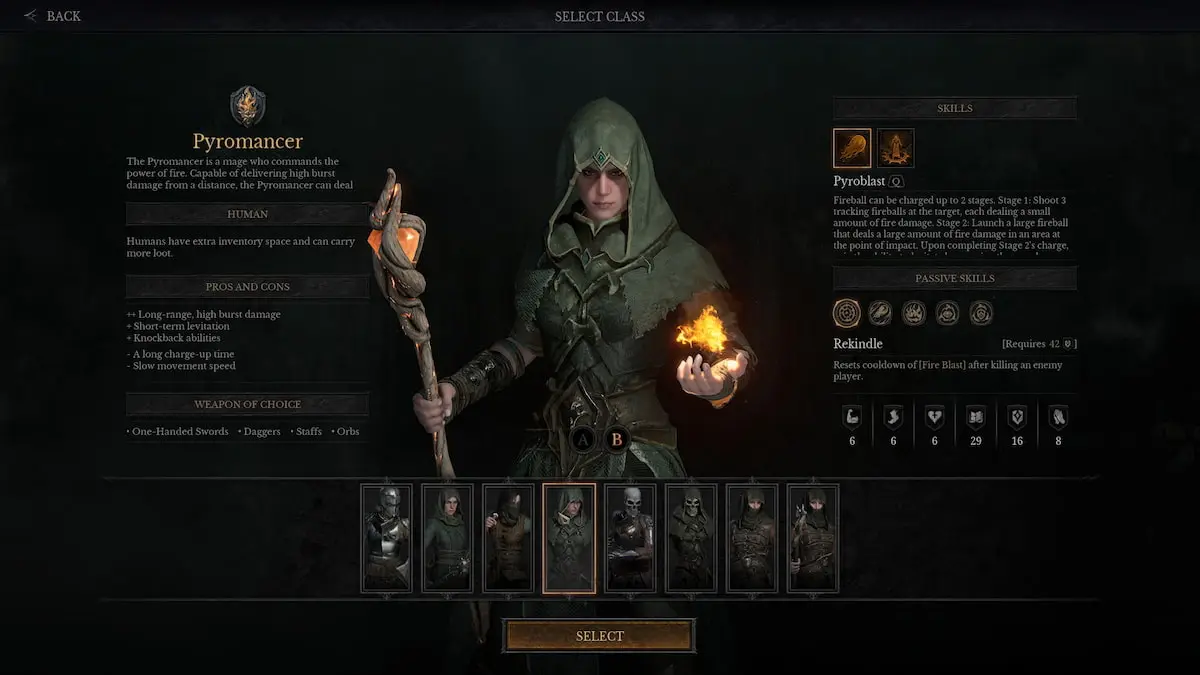
Strengths: Good at long range fighting and can counter melee fighters that get too close.
Weaknesses: Spells take time to fully charge and their movement is a bit slow.
The Pyromaniac is a wizard mostly suited for long-range combat. As the name suggests, all of their spells are fire-related. Their Q is a fireball spell that fires several small targeted fireballs when not fully charged and one large AOE fireball when fully charged. This, combined with their fire sticks, makes them a lethal force to players further away. This would typically make them unable to fend off closer enemies due to the spell time. However, Pyromancers have a secondary ability that knocks back incoming enemies as they deal fire damage. This gives them an advantage over melee attackers if used wisely. I’ve also found that their ability to set enemies on fire can help make them more visible in dark spaces. This is especially true for smaller enemies like bats and the more invisible ghost-like monsters.
5 – Death Knight
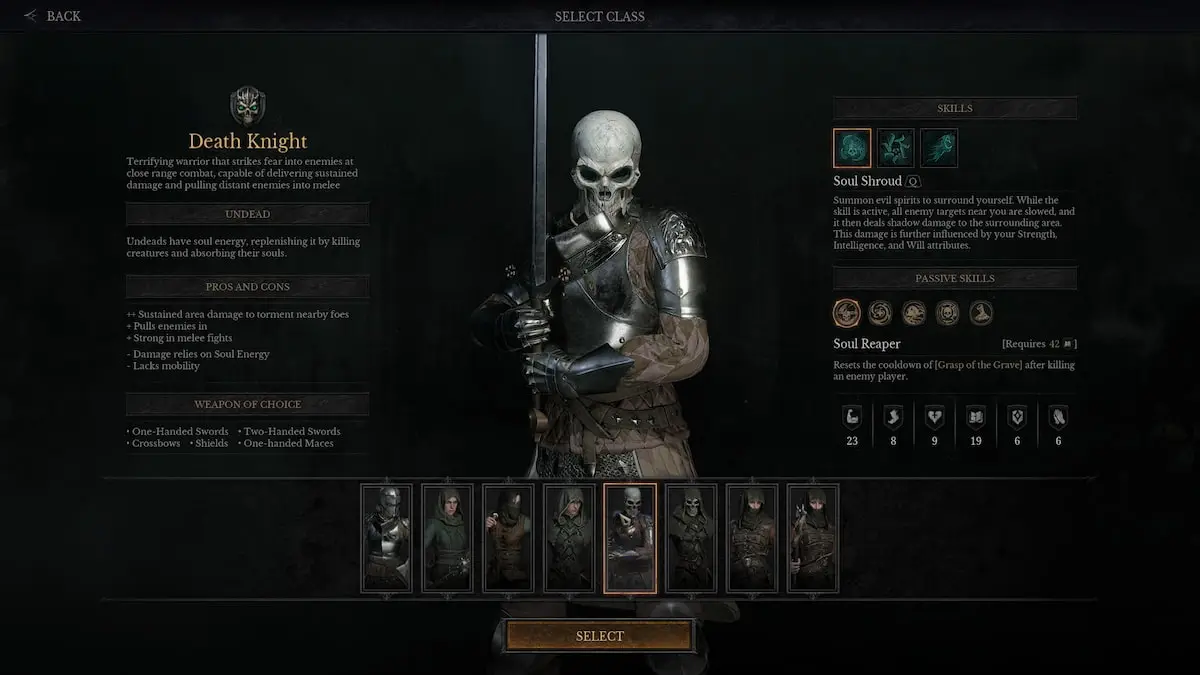
Strengths: A heavy hitter that can pull enemies to gain the upper hand.
Weaknesses: Not very mobile and relies heavily on collecting Soul Energy.
If you’re looking for a heavy hitter that gets up close and personal, the Death Knight class is for you. They are a strong, melee attacker that can easily overpower other classes in close combat. Their high attack is matched by their low speed.
However, what they lack in speed, they make up for in skills. Their E ability pulls enemies into them to give them an advantage in any battle. This is especially useful for drawing long-range or fragile fighters like Priests into the fray to take them out quickly. It is especially effective when combined with their Q spell to slow down the enemies and deal some extra damage.
Like Undead, the Death Knight class relies on Soul Energy rather than Mana to use spells. This won’t be too much of a problem as long as you upgrade their abilities so that their grip generates extra Soul Energy when you grab an enemy.
6 – Rogue
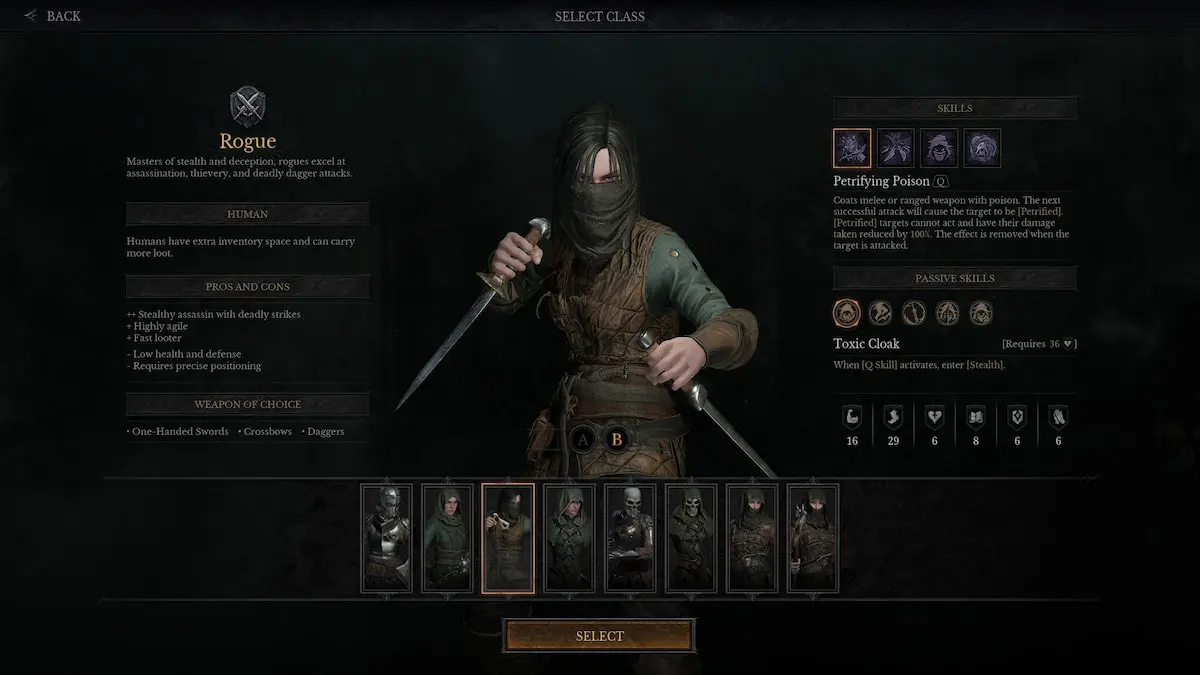
Strengths: Very skilled and able to sneak up on players using his stealth skills.
Weaknesses: They have low health and defense, forcing players to use their abilities wisely to survive dangerous situations.
The Rogue is a stealthy attacker who uses hit-and-run tactics to take down unprepared players, whether they’re classes better suited for long-range combat or simply separated from their group. Their abilities include turning invisible to launch sneak attacks and being able to poison their weapons to Stone opponents.
They can easily take on Priest and Cryomancer classes and have the upper hand due to surprise, their speed, and their damage. While they thrive in these situations, they struggle in others. They have a weaker build, making them an easy target for melee classes if caught unawares or using their ability improperly. You’ll also have to get used to using their dual-wielding techniques because it’s easy to miss shots on enemies if you’re used to regular one- or two-handed weapons.
7 – Priest
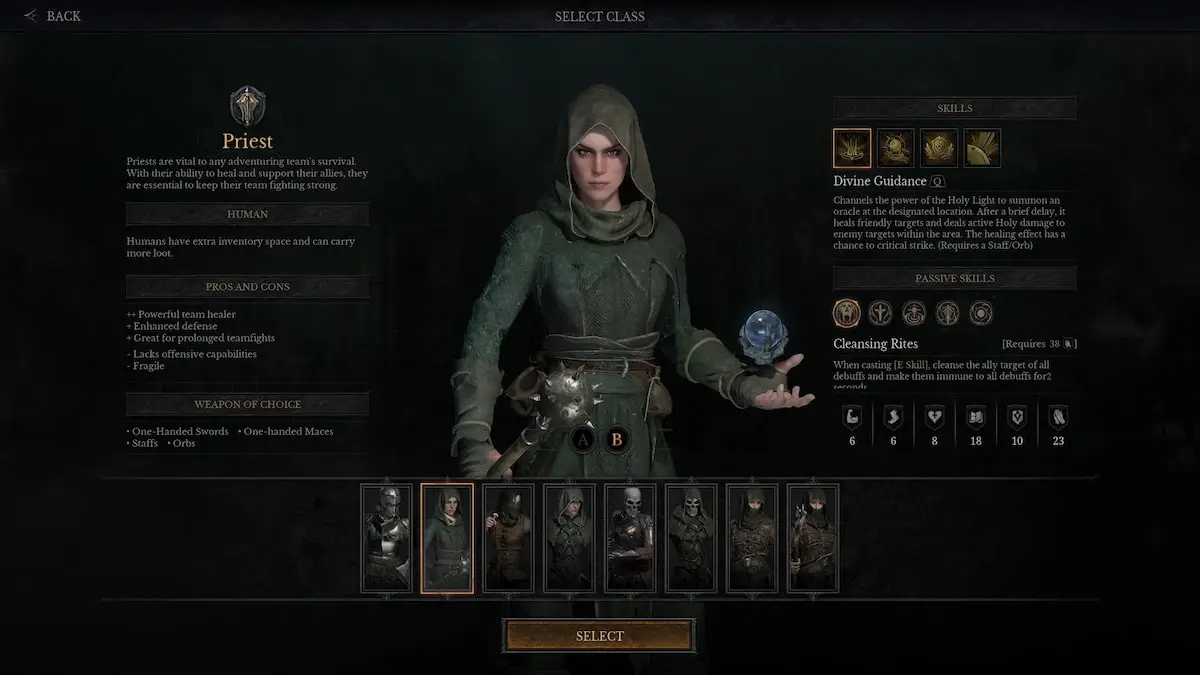
Strengths: They can do both direct and AOE healing, plus place shields on themselves and allies.
Weaknesses: They have low health, low defense, and not enough attack to stand on their own.
The Priest is the only true support-type class in Dungeonborne. Players can choose between two abilities for their Q, the first of which is an Area-of-Effect heal while the second is a charged player-specific heal. Each of their E abilities allows them to apply a shield to either themselves or their allies for a specific amount of time. This is good in theory because it saves materials and allows players to be healed even without supplies.
However, there are some definite disadvantages. Players will need to constantly replenish their mana to provide consistent healing to themselves and their team. Additionally, the amount of healing isn’t much compared to how much mana each heal requires. Finally, the biggest downside of the characters is how weak they are. They don’t do much damage, don’t have much defense, and don’t even have much health. If jumped by a Rogue or frontal character, Priests will fall 99% of the time. This makes them almost unplayable unless teamed up with two other players who can tank the damage and protect them.
8 – Cryomancer
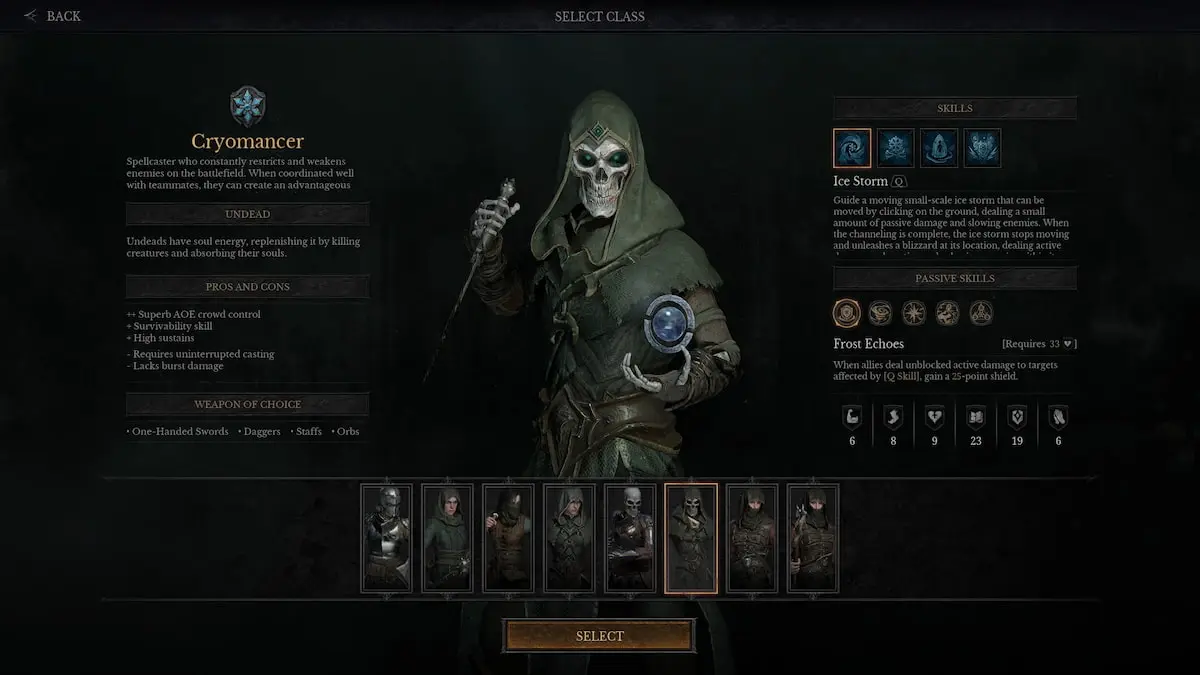
Strengths: Good for crowd-controlling groups during PVP situations.
Weaknesses: Does not have a good ability to regenerate their Soul Energy.
Cryomancers are wizards who employ ice-themed spells. Their Q spells are offensive and allow them to deal long-range damage to enemies in their sights. In contrast, their E spells are on the support side, allowing them to shield themselves or allies or even heal themselves. Like the Death Knight, their spells rely on Soul Energy instead of Mana.
Unfortunately, unlike the Death Knight, they just don’t have a great way to regenerate the Soul Energy themselves. This leaves them dependent on Mana potions to replenish their spell moves. This is easier to compensate for when you’re playing with one or two other people, but people playing alone will struggle to fight bigger monsters and other players when they run out of Soul Energy. This is especially true for those at the beginning of the game because they will have worse equipment that will not make up for the gap in skills.
Want to compare these classes to those in Dark and Darker? Check out our List of Dark and Darker Level – Best Class here on Pro Game Guides.




